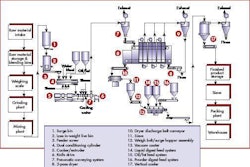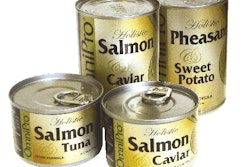The total US market for petfood and supplies, adjusted for inflation, grew more than 34% from 2002-07, according to IRI Infoscan data in an August 2007 report from Mintel (www.mintel.com). The study attributes some of that growth to pet owners spending more on products for their pets that are less utilitarian and more fun. Consumers are also becoming more discerning about the quality and makeup of products they feed their pets in light of the wide-scale petfood recalls that began in March 2007. Mintel expects the market to continue dynamic growth through 2012 as consumers continue to treat their pets as well as, or better than, they treat themselves.
For its report, Mintel commissioned exclusive consumer research through Greenfield Online to explore pet ownership and care. Fieldwork was conducted in May 2007 among a nationally representative sample (weighted against the total population for estimation) of 2,000 adults aged 18+. The report also includes data from Simmons Research, using the National Consumer Survey (NCS) and IRI's Infoscan data. Wal-Mart sales are not included in the IRI data, but Mintel estimates US sales of petfood and supplies through Wal-Mart will be US$3.7 billion in 2007, accounting for 15% of sales. Value figures are at retail selling prices (rsp) excluding sales tax.
Key findings
Hispanic outreach. Hispanics, a quickly growing part of the US market, are more likely than non-Hispanics to own a dog. Marketers should consider more outreach through channels that Hispanics are apt to use.
Changing channels. Mass merchandisers command 34.5% of the total market for petfood and supplies, compared to 22% for supermarkets and 19% for pet specialty stores. Mass merchandiser prices are 13-18% lower than the prices in traditional supermarkets, according to Progressive Grocer . On the other hand, pet specialty stores offer a "warm and fuzzy" shopping experience and frequent shopper programs.
Pets as reflection of self. The shifting perception of the family pet, from companion to reflection of oneself, continues unabated. Pet owners are increasingly interested in products and services on the higher end of the pet care spectrum.
The recall effect
A May 2007 Greenfield Online survey found that 93% of pet owners were aware of the petfood recalls. Asked if the petfood recalls changed their petfood purchases, 30% said yes and specified as follows:
- I changed the brand of petfood I buy - 62%.
- I made homemade petfood for my pet - 28%.
- I switched to organic petfood - 16%.
- I changed the retailer from which I buy petfood - 15%.
- Other reasons - 18%.
This shows that some pet owners will go to great lengths to care for their pets and keep them safe. Manufacturers have their work cut out for them in rebuilding trust with these consumers. However, Mintel believes that most of the organic/all- natural converts who switched due to the recall will not stay with these versions into 2008. Food safety scares often change consumers' behavior just temporarily.
Market drivers
Pet populations. According to the American Pet Products Manufacturers Association, there are approximately 88 million pet cats in the US today. Cats outnumber dogs by 14 million; however, the number of dogs increased 1.2% between 2005 and 2007, and the number of cats declined by 2.4% during that period.
Green products. Pro-environmental products and services for pets seem to have an especially bright future. Expect aglines like "Love your pet; love your Earth."
Obesity solutions. Pet owners are addressing pet obesity much as they would for themselves, creating opportunities for both traditional weight loss solutions and weight loss "shortcuts" for pets. Mimicking some human weight loss solutions, such as Jenny Craig for dogs, could be beneficial.
Aging pets. A significant percentage of U.S. pets have reached the mature lifestage15% of dogs and 17% of cats are over the age of 11. More pet owners will be purchasing more expensive lifestage- and condition-specific foods, supplements and treats, like those that address joint and digestive health, as well as those that maintain vision.
Dog food sales
Among US dog owners, dry food is the preferred type. The most cost-effective of the three types, dry dog food is available in larger sizes than wet and semi-moist varieties are. However, dry food does not have the same image of freshness that some wet foods have. Manufacturers like Pedigree have attempted to change this perception by introducing its products in resealable zipper bags.
Because the recent recalls primarily affected wet petfoods, Mintel expects to see a notable shift in 2007, with wet food buyers shifting to dry foods. More than three in four dog owners say they buy biscuits or treats. Like dry dog food, biscuits and treats were largely unscathed by the recalls; however, major manufacturer Del Monte did announce the recall of a number of its treat products on suspicion of contamination.
While use of dry dog food was scattered across a number of brands, wet dog food buyers appear to have a clear preference for the Pedigree and Alpo brands.
The Pedigree brand was not a part of the recall, which means that household penetration should remain steady or increase in 2007. An increase is likely as wet products from Alpo, Iams and Eukanuba were all voluntarily recalled, and some wet food consumers have switched brands as a result.
Cat food sales
Dry cat foods tend to be the staple foods used by US cat owners surveyed, although there appears to be a great degree of overlap in types of products used, with nearly half of cat owners saying they also use wet food. Dry cat food buyers are twice as likely as wet cat food buyers to say they use a light variety, which is not surprising given that wet cat food typically carries an indulgent positioning.
There appears to be a fair amount of overlap in the brands of treats/snacks used by cat owners. With cat owners being more likely to buy treats on impulse (as opposed to the planned purchase of food), it is likely that pet owners buy a regular treat that they know their pet likes and some other brand that looks good to them at the time.
The fact that not even 20% of cat owners use any one particular brand of listed dry cat food brands points to a highly populated dry cat food segment. As companies continue to merge (e.g., Del Monte acquiring Milk-Bone and Meow Mix in 2006), it will become even more important for manufacturers to evaluate product lines to discontinue non-performers and possibly merge brands where products overlap.
Just as was seen with wet dog food, cat owners have clear brand preferences, with the largest percentage reporting that they use Nestlé Purina's Friskies brand. Another 30% say they use the company's Fancy Feast brand.
Sunny forecast
Mintel uses the SPSS time series package to forecast the market to 2012. SPSS correlates historic market size data with key economic and demographic determinants, identifying factors having most influence on the market. Mintel expects US sales of petfood and supplies to rise to US$35.3 billion by 2012, an increase of 26% (adjusted for inflation).















